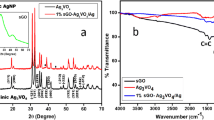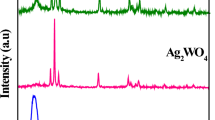Abstract
The sulfur-doped graphene oxide (sGO)–integrated Ag3PO4 composite displayed very high catalytic activity toward prominent water pollutants like textile dyes and fungicide under sunlight. The optimum amount of sGO doping was found as 5% for degradation. The novel composite degraded 99% of methylene blue (MB) in only 5 min of sunlight exposure, which is 16 and 8 times faster than Ag3PO4 and 5% GO-Ag3PO4. High mineralization was observed for MB with a total organic carbon (TOC) removal of 98% in 30 min. The composite mineralized rhodamine B, methyl orange, and acid red 18 dyes with a TOC removal above 95%. Moreover, a toxic dithiocarbamate fungicide thiram was degraded in 1 h with a TOC removal of 82% leaving less toxic thiourea. The formation of sGO-Ag3PO4 n-n heterojunction increases charge transport and photocatalytic activity of the composite to incredible extent along with hollow morphology and in situ formed Ag nanoparticles (AgNPs).











Similar content being viewed by others
Data availability
Not applicable.
References
Abraham T, Rejil KR, George JM, Antony A, Pillai SC, Hinder SJ et al (2019) Magnetic Fe3O4–reduced graphene oxide composite decorated with Ag nanoparticles as electrochemical sensor and self-cleaning material for organic pollutants. J Porous Mater 27(1):303–318. https://doi.org/10.1007/s10934-019-00814-x
Akbarzadeh E, Setayesh SR, Gholami MR (2016) Synthesis of the visible-light-driven Ag3VO4/Ag3PO4/Ag photocatalysts with enhanced photocatalytic activity. RSC Adv 6(18):14909–14915. https://doi.org/10.1039/c6ra00279j
Al Kausor M, Gupta SS, Chakrabortty D (2020) Ag3PO4-based nanocomposites and their applications in photodegradation of toxic organic dye contaminated wastewater: review on material design to performance enhancement. J Saudi Chem Soc 24(1):20–41. https://doi.org/10.1016/j.jscs.2019.09.001
Bu Y, Chen Z (2014) Role of polyaniline on the photocatalytic degradation and stability performance of the polyaniline/silver/silver phosphate composite under visible light. ACS Appl Mater Interfaces 6(20):17589–17598. https://doi.org/10.1021/am503578s
Chen L, Cui X, Wang Y, Wang M, Qiu R, Shu Z et al (2014) One-step synthesis of sulfur doped graphene foam for oxygen reduction reactions. Dalton Trans 43(9):3420. https://doi.org/10.1039/c3dt52253a
Chen P, Wang F, Chen Z-F, Zhang Q, Su Y, Shen L et al (2017) Study on the photocatalytic mechanism and detoxicity of gemfibrozil by a sunlight-driven TiO2/carbon dots photocatalyst: the significant roles of reactive oxygen species. Appl Catal B Environ 204:250–259. https://doi.org/10.1016/j.apcatb.2016.11.040
Cui C, Wang Y, Liang D, Cui W, Hu H, Lu B et al (2014) Photo-assisted synthesis of Ag3PO4/reduced graphene oxide/Ag heterostructure photocatalyst with enhanced photocatalytic activity and stability under visible light. Appl Catal B Environ 158-159:150–160. https://doi.org/10.1016/j.apcatb.2014.04.007
Das DP, Barik RK, Das J, Mohapatra P, Parida KM (2012) Visible light induced photo-hydroxylation of phenol to catechol over RGO–Ag3VO4 nanocomposites without the use of H2O2. RSC Adv 2(19):7377. https://doi.org/10.1039/c2ra20703f
Das DP, Samal A, Das J, Dash A, Gupta H (2013) One-pot fabrication of RGO-Ag3VO4 nanocomposites by in situ photoreduction using different sacrificial agents: high selectivity toward catechol synthesis and photodegradation ability. Photochem Photobiol 90(1):57–65. https://doi.org/10.1111/php.12172
Deng Y, Tang L, Feng C, Zeng G, Wang J, Zhou Y et al (2018) Construction of plasmonic Ag modified phosphorous-doped ultrathin g-C3N4 nanosheets/BiVO4 photocatalyst with enhanced visible-near-infrared response ability for ciprofloxacin degradation. J Hazard Mater 344:758–769. https://doi.org/10.1016/j.jhazmat.2017.11.027
Dong H, Chen G, Sun J, Li C, Yu Y, Chen D (2013a) A novel high-efficiency visible-light sensitive Ag2CO3 photocatalyst with universal photodegradation performances: simple synthesis, reaction mechanism and first-principles study. Appl Catal B Environ 134-135:46–54. https://doi.org/10.1016/j.apcatb.2012.12.041
Dong P, Wang Y, Cao B, Xin S, Guo L, Zhang J et al (2013b) Ag3PO4/reduced graphite oxide sheets nanocomposites with highly enhanced visible light photocatalytic activity and stability. Appl Catal B Environ 132-133:45–53. https://doi.org/10.1016/j.apcatb.2012.11.022
Dong P, Hou G, Liu C, Zhang X, Tian H, Xu F et al (2016) Origin of activity and stability enhancement for Ag3PO4 photocatalyst after calcination. Materials 9(12):968. https://doi.org/10.3390/ma9120968
Ghoul I, Debbache N, Dekkiche BA, Seraghni N, Sehili T, Marín Z et al (2019) Fe(III)-Citrate enhanced sunlight-driven photocatalysis of aqueous carbamazepine. J Photochem Photobiol A 378:147–155. https://doi.org/10.1016/j.jphotochem.2019.04.018
Gliniak J, Lin J-H, Chen Y-T, Li C-R, Jokar E, Chang C-H et al (2017) Sulfur-doped graphene oxide quantum dots as photocatalysts for hydrogen generation in the aqueous phase. ChemSusChem 10(16):3260–3267. https://doi.org/10.1002/cssc.201700910
Han W, Chen L, Song W, Wang S, Fan X, Li Y et al (2018) Synthesis of nitrogen and sulfur co-doped reduced graphene oxide as efficient metal-free cocatalyst for the photo-activity enhancement of CdS. Appl Catal B Environ 236:212–221. https://doi.org/10.1016/j.apcatb.2018.05.021
Hsieh M-S, Su H-J, Hsieh P-L, Chiang Y-W, Huang MH (2017) Synthesis of Ag3PO4 crystals with tunable shapes for facet-dependent optical property, photocatalytic activity, and electrical conductivity examinations. ACS Appl Mater Interfaces 9(44):39086–39093. https://doi.org/10.1021/acsami.7b13941
Hummers WS, Offeman RE (1958) Preparation of graphitic oxide. J Am Chem Soc 80(6):1339–1339. https://doi.org/10.1021/ja01539a017
Joseph S, Abraham S, Abraham T, Priyanka RN, Mathew B (2019a) S-rGO modified sulphur doped carbon nitride with mixed-dimensional hierarchical nanostructures of silver vanadate for the enhanced photocatalytic degradation of pollutants in divergent fields. Appl Surf Sci 495:143478. https://doi.org/10.1016/j.apsusc.2019.07.220
Joseph S, Abraham S, Priyanka RN, Abraham T, Suresh A, Mathew B (2019b) In situ S-doped ultrathin gC3N4 nanosheets coupled with mixed-dimensional (3D/1D) nanostructures of silver vanadates for enhanced photocatalytic degradation of organic pollutants. New J Chem 43(26):10618–10630. https://doi.org/10.1039/c9nj01353a
Karikalan N, Karthik R, Chen S-M, Karuppiah C, Elangovan A (2017) Sonochemical synthesis of sulfur doped reduced graphene oxide supported CuS nanoparticles for the non-enzymatic glucose sensor applications. Sci Rep 7(1). https://doi.org/10.1038/s41598-017-02479-5
Kumar S, Kumar A (2016) Chemically derived luminescent graphene oxide nanosheets and its sunlight driven photocatalytic activity against methylene blue dye. Opt Mater 62:320–327. https://doi.org/10.1016/j.optmat.2016.10.014
Lebogang L, Bosigo R, Lefatshe K, Muiva C (2019) Ag3PO4/nanocellulose composite for effective sunlight driven photodegradation of organic dyes in wastewater. Mater Chem Phys 236:121756. https://doi.org/10.1016/j.matchemphys.2019.121756
Patil SS, Mali MG, Roy A, Tamboli MS, Deonikar VG, Patil DR et al (2016) Graphene-wrapped Ag3PO4/LaCO3OH heterostructures for water purification under visible light. J Energy Chem 25(5):845–853. https://doi.org/10.1016/j.jechem.2016.05.004
Priyanka RN, Joseph S, Abraham T, Plathanam NJ, Mathew B (2020) Rapid sunlight-driven mineralisation of dyes and fungicide in water by novel sulphur-doped graphene oxide/Ag3VO4 nanocomposite. Environ Sci Pollut Res 27(9):9604–9618. https://doi.org/10.1007/s11356-019-07569-7
Ragam PN, Mathew B (2019) Unmodified silver nanoparticles for dual detection of dithiocarbamate fungicide and rapid degradation of water pollutants. Int J Environ Sci Technol 17(3):1739–1752. https://doi.org/10.1007/s13762-019-02454-9
Ran R, McEvoy JG, Zhang Z (2016) Ag2O/Ag3VO4/Ag4V2O7 heterogeneous photocatalyst prepared by a facile hydrothermal synthesis with enhanced photocatalytic performance under visible light irradiation. Mater Res Bull 74:140–150. https://doi.org/10.1016/j.materresbull.2015.08.028
Singh A, Baruah A, Katoch V, Vaghasiya K, Prakash B, Ganguli AK (2018) Continuous flow synthesis of Ag3PO4 nanoparticles with greater photostability and photocatalytic dye degradation efficiency. J Photochem Photobiol A 364:382–389. https://doi.org/10.1016/j.jphotochem.2018.05.017
Tian Z, Li J, Zhu G, Lu J, Wang Y, Shi Z et al (2016) Facile synthesis of highly conductive sulfur-doped reduced graphene oxide sheets. Phys Chem Chem Phys 18(2):1125–1130. https://doi.org/10.1039/c5cp05475c
Wang S, Zhai Y-Y, Gao Q, Luo W-J, Xia H, Zhou C-G (2013) Highly efficient removal of Acid Red 18 from aqueous solution by magnetically retrievable chitosan/carbon nanotube: batch study, isotherms, kinetics, and thermodynamics. J Chem Eng Data 59(1):39–51. https://doi.org/10.1021/je400700c
Wang Z, Li P, Chen Y, He J, Zhang W, Schmidt OG et al (2014) Pure thiophene–sulfur doped reduced graphene oxide: synthesis, structure, and electrical properties. Nanoscale 6(13):7281. https://doi.org/10.1039/c3nr05061k
Wang J-C, Lou H-H, Xu Z-H, Cui C-X, Li Z-J, Jiang K et al (2018) Natural sunlight driven highly efficient photocatalysis for simultaneous degradation of rhodamine B and methyl orange using I/C codoped TiO2 photocatalyst. J Hazard Mater 360:356–363. https://doi.org/10.1016/j.jhazmat.2018.08.008
Wetchakun K, Wetchakun N, Sakulsermsuk S (2019) An overview of solar/visible light-driven heterogeneous photocatalysis for water purification: TiO2- and ZnO-based photocatalysts used in suspension photoreactors. J Ind Eng Chem 71:19–49. https://doi.org/10.1016/j.jiec.2018.11.025
Wu C (2015) Synthesis of Ag2CO3/CeO2 microcomposite with visible light-driven photocatalytic activity. Mater Lett 152:76–78. https://doi.org/10.1016/j.matlet.2015.03.086
Xu Y-S, Zhang W-D (2013) Monodispersed Ag3PO4 nanocrystals loaded on the surface of spherical Bi2MoO6 with enhanced photocatalytic performance. Dalton Trans 42(4):1094–1101. https://doi.org/10.1039/c2dt31634j
Yang Z, Yao Z, Li G, Fang G, Nie H, Liu Z et al (2011) Sulfur-doped graphene as an efficient metal-free cathode catalyst for oxygen reduction. ACS Nano 6(1):205–211. https://doi.org/10.1021/nn203393d
Zhang Y, Chu M, Yang L, Deng W, Tan Y, Ma M et al (2014) Synthesis and oxygen reduction properties of three-dimensional sulfur-doped graphene networks. Chem Commun 50(48):6382. https://doi.org/10.1039/c4cc01939c
Zhang X, An D, Feng D, Liang F, Chen Z, Liu W et al (2019) In situ surfactant-free synthesis of ultrathin BiOCl/g-C3N4 nanosheets for enhanced visible-light photodegradation of rhodamine B. Appl Surf Sci 476:706–715. https://doi.org/10.1016/j.apsusc.2019.01.147
Zhao T, Xing Z, Xiu Z, Li Z, Chen P, Zhu Q et al (2019) Synergistic effect of surface plasmon resonance, Ti3+ and oxygen vacancy defects on Ag/MoS2/TiO2-x ternary heterojunctions with enhancing photothermal catalysis for low-temperature wastewater degradation. J Hazard Mater 364:117–124. https://doi.org/10.1016/j.jhazmat.2018.09.097
Zhou D, Wang Y-Y, Wang F-R, Liu J-K, Zhang X-M (2019) Design and application of Ag3PO4@Ag4V2O7 Z-scheme photocatalysts with a micro-nano tube-cluster structure for the co-degradation of nitrate and ammonia in wastewater. Ind Eng Chem Res 58(39):18027–18035. https://doi.org/10.1021/acs.iecr.9b03623
Zhu D, Zhou Q (2019) Action and mechanism of semiconductor photocatalysis on degradation of organic pollutants in water treatment: a review. Environ Nanotechnol Monit Manag 12:100255. https://doi.org/10.1016/j.enmm.2019.100255
Zhu Q, Wang W-S, Lin L, Gao G-Q, Guo H-L, Du H et al (2013) Facile synthesis of the novel Ag3VO4/AgBr/Ag plasmonic photocatalyst with enhanced photocatalytic activity and stability. J Phys Chem C 117(11):5894–5900. https://doi.org/10.1021/jp400842r
Funding
Kerala State Council for Science Technology and Environment (KSCSTE), Kerala, India, provided research fellowship to RNP.
Author information
Authors and Affiliations
Contributions
RNP contributed in the conceptualization, methodology, and resources as well as in writing the original draft. TA, SJ, JMG, and NJP participated in data curation and visualization. BM contributed in the conceptualization, supervision, project administration, review, and editing of the manuscript. All the authors actively participated in the reading and approval of final manuscript.
Corresponding author
Ethics declarations
Ethics approval and consent to participate
Not applicable.
Conflict of interest
The authors declare that they have no conflict of interest.
Additional information
Responsible Editor: Santiago V. Luis
Publisher’s note
Springer Nature remains neutral with regard to jurisdictional claims in published maps and institutional affiliations.
Highlights
• One-pot fabrication of sGO-Ag3PO4/Ag was achieved at normal conditions
• sGO acts as a cocatalyst to enhance the photocatalytic activity of Ag3PO4 more than 16-fold
• Degraded dyes and fungicide with high mineralization rates in less time
• sGO sheet provides more electrons, promotes maximum organic pollutant adsorption, and reduces photocorrosion of Ag3PO4 catalyst
• sGO-Ag3PO4 forms n-n heterojunction, facilitates high charge carrier separation as well as mobility, and reduces e-–h+ recombination
• Ag(0) formed in situ during synthesis and later on light exposure boosts the activity of the photocatalyst
• Rapid and superior catalytic activity under sunlight was found over most of the composites with metallic cocatalysts toward the sunlight-driven mineralization of water pollutants such as fungicide and textile dyes
• High competency of the composite was for textile effluent treatment with around 89% TOC removal
Supplementary Information
ESM 1
(DOCX 1811 kb)
Rights and permissions
About this article
Cite this article
Priyanka, R.N., Abraham, T., Joseph, S. et al. Fast and efficient degradation of water pollutant dyes and fungicide by novel sulfur-doped graphene oxide–modified Ag3PO4 nanocomposite. Environ Sci Pollut Res 28, 20247–20260 (2021). https://doi.org/10.1007/s11356-020-11884-9
Received:
Accepted:
Published:
Issue Date:
DOI: https://doi.org/10.1007/s11356-020-11884-9




